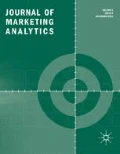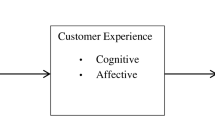Abstract
Customer satisfaction level is one of key performance indicators in the service industry. The various factors affecting this are studied to maintain an excellent relationship with customers. Self-service technology (SST) is widely implemented by companies in service sector. This paper proposes to apply the customer satisfaction survey to investigate factors influencing the customer satisfaction. The relationships among the factors are discovered using PC-algorithm. The critical factors are identified to be inputs in regression tree and ANN to estimate the customer satisfaction level. By means of comparison of models, importance of selected inputs is quantified and discussed. The results show that customer satisfaction has strong connectivity relationship with personal service attributes as well as affective and temporal commitment by running PC-algorithm. ANN validated by 10-fold cross validation is the best among the models. The most important factor influencing the satisfaction level to the companies is the customer’s desire of continuing a relationship. The key benefit of the proposed approach is to avoid making subjective decisions, for instance, building a plausible initial path models in the analysis. The analytical results facilitate the decision-making process and better resource allocation in the airline and state its future development of self-service technology.









Similar content being viewed by others
References
Abdelaziz, G.S., A.A. Hegazy, and A. Elabbassy. 2010. Study of Airport Self-service Technology within Experimental Research of Check-In Techniques Case Study and Concept. International Journal of Computer Science 7 (3): 17–26.
Alcock, T., and N. Millard. 2007. Self-service—But it is Good to Talk? BT Technology Journal 25 (3): 313–320.
Anderson, E.W., C. Fornell, and D.R. Lehman. 1994. Customer Satisfaction, Market Share, and Profitability: Findings from Sweden. Journal of Marketing 58 (3): 53–56.
Bateson, J.E. 1985. Self-service Consumer: An Exploratory Study. Journal of Retailing 61 (3): 49–76.
Beatson, A.N. 2007. Self-Service Technology and the Service Encounter. The Service Industries Journal 27 (1): 75–89.
Beatson, A., V.L. Coote, and M.J. Rudd. 2006. Determining Consumer Satisfaction and Commitment Through Self-service Technology and Personal Service Usage. Journal of Marketing Management 22 (7–8): 853–882.
Becker, S.H. 1960. Notes on the Concept of Commitment. American Journal of Sociology 66 (1): 32–40.
Brockman, J. 2009. Airlines Boost Self-service with Mobile Check-in, from NPR Organization. http://www.npr.org/templates/story/story.php?storyId=103781402. Accessed 12 March 2016.
De’ath, G., and K.E. Fabricius. 2000. Classification and Regression Tree: A Powerful Yet Simple Techniques for Ecological Data Analysis. Ecology 81 (11): 3178–3192.
Drennen, H. 2011. Self Service Technology in Airports and the Customer Experience. Las Vegas: University of Nevada.
Esaki, K. 2013. Prediction Models for Total Customer Satisfaction Based. American Journal of Operations Research 3 (4): 393–401.
Fornell, C., and D. Larcker. 1981. Structural Equation Models with Unobservable Variables and Measurement Error: Algebra and statistics. Journal of Marketing Research 18 (3): 382–388.
Garbarino, E., and M.S. Johnson. 2001. Effects of Consumer Goals on Attribute Weighting, Overall Satisfaction, and Product Usage. Psychology & Marketing 18 (9): 929–949.
Garson, G.D. 1992. Interpreting Neural-network Connection Weights. AI Expert 6 (4): 47–51.
Hastie, T., R. Tibshirani, and J. Friedman. 2009. The Elements of Statistical Learning Data Mining, Inference, and Prediction. California: Springer.
Hsieh, C.T. 2005. Implementing Self-service Technology to Gain Competitive Advantages. Communications of the IIMA 15 (1): 77–83.
Kalisch, M., and P. Buhlmann. 2008. Robustification of PC-algorithm for Directed Acyclic Graphs. Journal of Computational and Graphical Statistics 17 (4): 773–789.
Keiningham, L.T., B. Cooil, L. Aksoy, W.T. Andreassen, and J. Weiner. 2007. The Value of Different Customer Satisfaction and Loyalty Metrics in Predicting Customer Retention, Recommendation, and Share-of-Wallet. Managing Service Quality 17 (4): 361–384.
Kim, K., and G.L. Frazier. 1997. On Distributor Commitment in Industrial Channels of Distribution: A Multicomponent Approach. Psychology & Marketing 14 (8): 847–877.
Kohavi, R. 1995. A Study of Cross-Validation and Bootstrap for Accuracy Estimation and Model Selection. IJCAI’95 Proceedings of the 14th International Joint Conference on Artificial intelligence—Vol. 2, pp. 1137–1143).
Langeard, E., E.G.J. Bateson, H.C. Lovelock, and P. Eiglier. 1981. Services Marketing: New Insights from Consumers and Managers. Cambridge: Marketing Science Institute.
Larasati, A., C. DeYong, and L. Slevitch. 2012. The Application of Neural Network and Logistics Regression Models on Predicting Customer Satisfaction in a Student-Operated Restaurant. Procedia—Social and Behavioral Sciences 5: 94–99.
Lewis, J.R. 2000. An Introduction to Classification and Regression Tree (CART) Analysis. California: Department of Emergency Medicine, Harbor-UCLA Medical Center.
Loh, W. 2008. Classification and Regression Tree Methods. Madison: University of Wisconsin.
Maind, B.S., and P. Wankar. 2014. Research Paper on Basic of Artificial Neural Network. International Journal on Recent and Innovation Trends in Computing and Communication 2 (1): 96–100.
Markoff, J. 2013. The Rapid Advance of Artificial Intelligence. http://www.nytimes.com/2013/10/15/technology/the-rapid-advance-of-artificial-intelligence.html?pagewanted=all&_r=0. Accessed 18 March 2016.
Meuter, L.M., L.A. Ostrom, I.R. Roundtree, and J.M. Bitner. 2000. Self-service Technologies: Understanding Customer Satisfaction with Technology-Based Service Encounters. Journal of Marketing 64 (3): 50–64.
Mitchell, M.T. 1997. Machine Learning. USA: McGraw Hill.
Mittal, V., W.T.J. Ross, and P.M. Baldasare. 1998. The Asymmetric Impact of Negative and Positive Attribute-Level Performance on Overall Satisfaction and Repurchase Intentions. Journal of Marketing 62 (1): 33–47.
Morgan, M.R., and D.S. Hunt. 1994. The Commitment-Trust Theory of Relationship Marketing. Journal of Marketing 58 (3): 20–38.
Oliver, R.L. 1993. Cognitive, Affective, and Attribute Bases of the Satisfaction Response. Journal of Consumer Research 20 (3): 418–430.
Rayport, J.F., and J.J. Sviokla. 1994. Managing in the Marketplace. Harvard Business Review 72: 2–11.
Ripley, D.B. 1996. Pattern Recognition and Neural Networks. Cambridge: Cambridge University Press.
Srihumppa, R. 2004. Understanding Technology-Based Self-Service Encounters: Asian Services In: The New Era. Asia Academy of Management Fourth Conference, Shanghai, pp. 1–7.
Sung, A.H. 1998. Ranking Importance of Input Parameters of Neural Networks. Expert Systems with Applications 15 (3–4): 405–411.
Tsaur, S.H., Y.C. Chiu, and C.H. Huang. 2002. Determinants of Guest Loyalty to International Tourist Hotels—A Neural Network Approach. Tourism Management 23 (4): 397–405.
Yoon, Y., T. Guimaraes, and G. Swales. 1994. Integrating Artificial Neural Networks with Rule-based Expert Systems. Decision Support Systems 11 (5): 497–507.
Author information
Authors and Affiliations
Corresponding author
Rights and permissions
About this article
Cite this article
Yau, H.K., Tang, H.Y.H. Analyzing customer satisfaction in self-service technology adopted in airports. J Market Anal 6, 6–18 (2018). https://doi.org/10.1057/s41270-017-0026-2
Revised:
Published:
Issue Date:
DOI: https://doi.org/10.1057/s41270-017-0026-2




